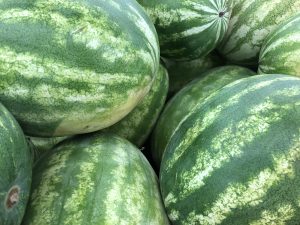We tend to think of watermelon as a summer fruit and that is because in Florida, you can find watermelons growing from late spring through mid-summer. “Fresh From Florida” watermelons are available in stores and roadside markets from April through July. Time is running out this summer to have a fresh Florida watermelon, so be sure to get them soon.
Why is watermelon such a popular fruit? One, it is in high abundance during the summer and can be found in most stores. Watermelon also tends to appeal to those with a “sweet tooth,” but it’s still healthy. Red watermelon is a good source of lycopene, which gives watermelon its color (and tomatoes, too). Lycopene is an antioxidant that helps protect the body against heart disease, inflammation, and some cancers.
Watermelon also is a good source of vitamin C and contains vitamin A. Vitamin C is an antioxidant, helping to protect cells from the damage caused by free radicals. Free radicals are compounds formed when our bodies convert the food we eat into energy. People also are exposed to free radicals in the environment from cigarette smoke, air pollution, and ultraviolet light from the sun. The body also needs vitamin C to make collagen, a protein required to help wounds heal. In addition, vitamin C improves the absorption of iron from plant-based foods and helps the immune system work properly to protect the body from disease. Vitamin A is important for normal vision, the immune system, and reproduction. Vitamin A also helps the heart, lungs, kidneys, and other organs work properly.
Probably most impressive is that watermelon is fat free, sodium free and cholesterol free, so we all should feel good about eating it. In addition, as the summer heat continues to increase, we need to drink more water to stay hydrated. Well, watermelon is 92% water, so eating it is an additional way to hydrate. In fact, early explorers used watermelons as canteens.
Here is a technique to know you have chosen a ripe watermelon. Ripe watermelons have a yellow or cream-yellow “ground spot” where the melon rested on the soil. If this spot is green or white, the watermelon probably is not ripe. In addition, once you have selected a ripe melon, a whole watermelon will last in the refrigerator for up to a week.
Before cutting your watermelon, be sure to wipe it with a clean cloth and light, soapy water and then rinse it off. This will prevent you from dragging any bacteria, etc. on the skin through the fruit as you slice it. Once cut, the melon should be kept refrigerated and covered with plastic wrap. If the watermelon flavor is not quite what you expected, you can enhance the flavor by adding a squeeze of lemon juice, honey, or chopped mint.
Be sure to excite your taste buds this summer by biting into a cold, sweet, juicy slice of watermelon. Feel confident in selecting your ripe watermelon and enjoy it, knowing you have made a healthy choice in your food selection.
A Few Fun Facts: (www.freshfromflorida.com/farmtoschool)
- Watermelon seeds are a good source of healthy fats and protein, which help your muscles grow.
- Florida leads the United States in watermelon production.
- Watermelons have been in production since around 2000 BCE.
- Seedless watermelons have been growing in the United States for over 40 years.
- Some countries, like Japan, grow square watermelons.
- Watermelons can have up to a thousand seeds, which can be black or white.
- As it matures, the watermelon’s insides transform from white to red or pink.
- You can eat the crunchy rind and seeds of a watermelon.
- According to John Mariani’s The Dictionary of American Food and Drink, the word “watermelon” first appeared in English dictionaries in 1615.
- Watermelon is the most consumed melon in the United States.
Resources:
Florida Department of Agriculture and Consumer Services
- Back to School Basics – The Importance of Prioritizing Sleep - August 28, 2024
- Let’s Go Walking – Celebrate National Walking Day – April 3, 2024 - April 1, 2024
- Busy days. Easy dinners. - March 8, 2023

